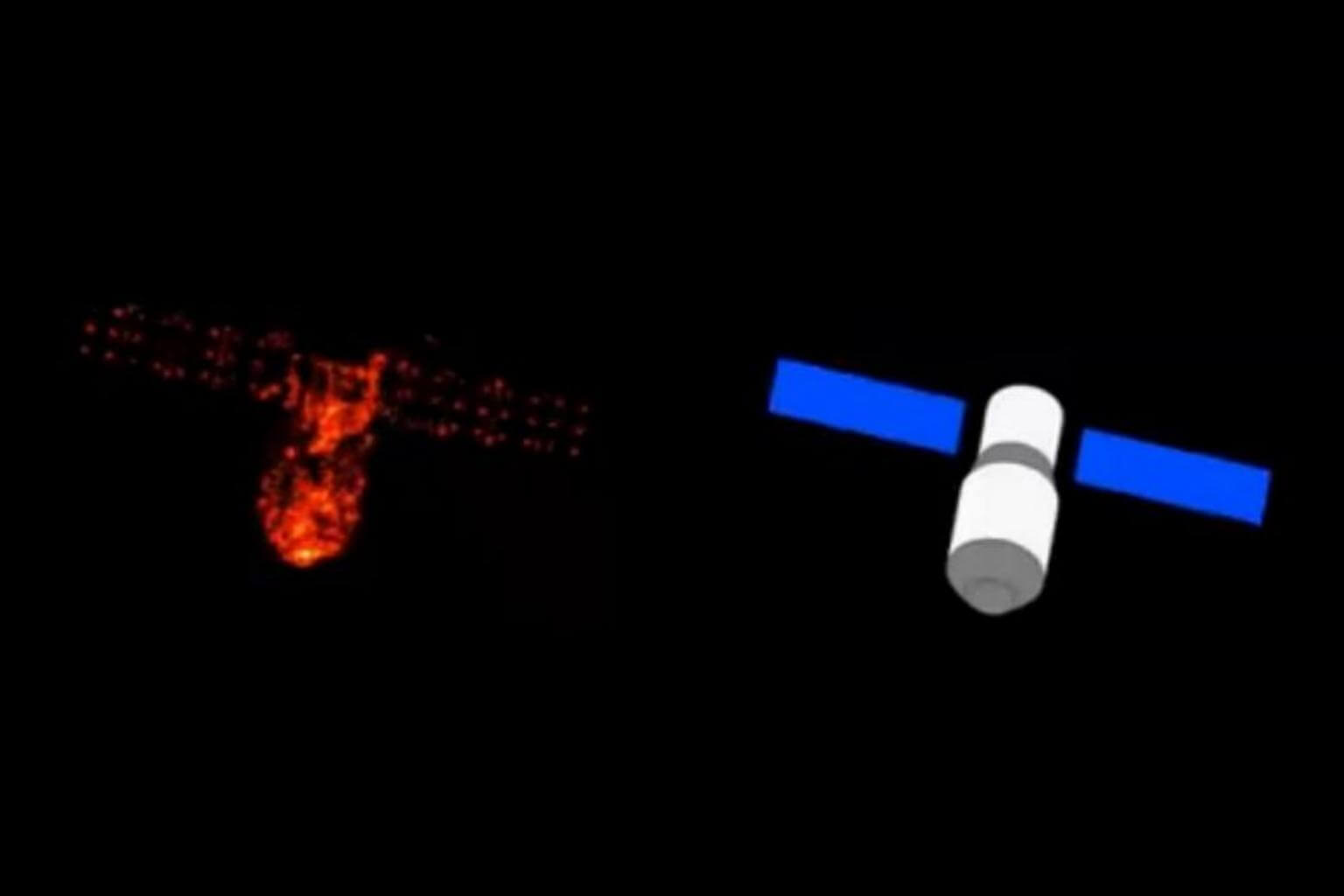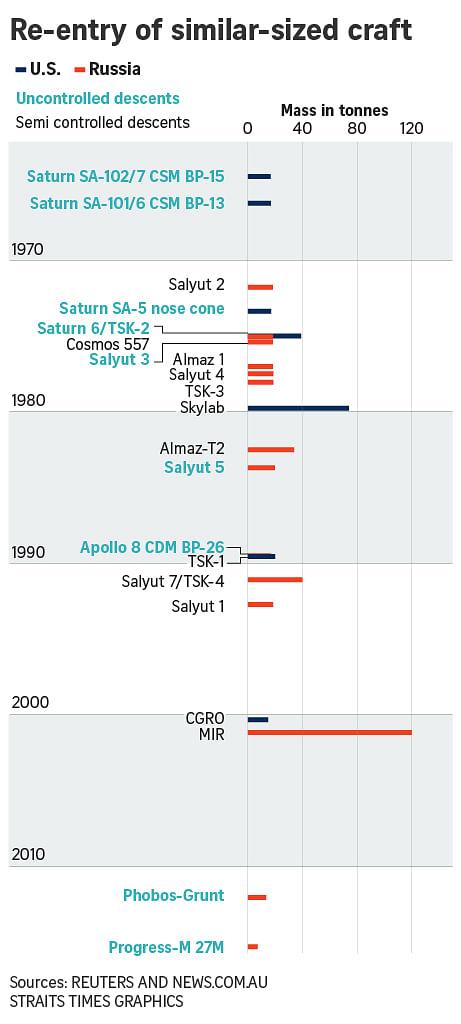Chinese satellite Tiangong-1 crashes back to Earth: 5 things you need to know about space junk
Sign up now: Get ST's newsletters delivered to your inbox

In March 2016, China lost contact with Tiangong-1 and could not guide the station to the middle of an ocean.
PHOTO: TWITTER/FRAUNHOFER FHR ENGL.
Follow topic:
Since the first satellites were launched in the mid-20th century, the Earth's orbit has long been treated by nations as a waste site nobody felt responsible for.
Spent rockets or old satellites now mingle with smaller pieces of trash left behind by human space programmes. All of those pieces zig around faster than speeding bullets. China's defunct space lab Tiangong-1 is only the latest on the list.
Here's a look at the phenomenon.
1. WHAT IS SPACE JUNK?
The European Space Agency (ESA) estimates that there are now more than 170 million pieces of space debris in circulation, though only 29,000 of those are larger than about four inches.
Congestion isn't spread evenly around Earth: While you have some scattered pieces further away, there is a concentration of objects within the so-called geosynchronous region, at about 35,784km altitude.
The highest density of objects can be found in low Earth orbit within 1,996km of Earth. That is also where most satellites can be found.
2. WHY IS SPACE JUNK DANGEROUS?
While smaller space debris objects may not pose a threat to Earth because they would disintegrate before reaching the surface, any of these objects can cause harm to an operational spacecraft.
A collision with a (four-inch) object would entail a catastrophic fragmentation of a typical satellite, according to the ESA.
Smaller pieces could still destroy spacecraft systems or penetrate shields, possibly making bigger satellites such as Tiangong-1 unresponsive and turning them into massive pieces of space debris themselves.
3. WHO IS MONITORING?
The US military and NASA are both in charge of elaborate schemes to track objects bigger than four inches and move active equipment out of the way.
Some of the more than 50 nations now operating their own space programmes have their own cleanup initiatives. Britain and Switzerland have experimented with schemes to clean up the mess by collecting the debris in circulation.
Some 250 to 300 spacecraft - which have mostly burned up as they carved a path through Earth's atmosphere - have been laid to rest at a remove watery graveyard called Point Nemo in the Pacific Ocean.
Named in honour of Jules Verne's fictional submarine captain, Point Nemo is further from land than any other dot on the globe: 2,688km from the Pitcairn Islands to the north, one of the Easter Islands to the northwest, and Maher Island - part of Antarctica - to the South.
4. LEGAL CHALLENGES
No single nation or entity is responsible for space although in 1959 the UN set up a Committee on the Peaceful Uses of Outer Space (COPUOS).
"There are currently 85 countries that are members of this committee and they range from space powers such as the US, Russia and China to countries like Costa Rica that don't even have a satellite in orbit but are an end user of satellite functions," says Brian Weeden of the Secure World Foundation, a Washington based organisation dedicated to the sustainable use of space.
Joan Johnson-Freese, a Naval War College professor, noted that there are no salvage laws in space. "Even if we had the political will to (salvage junk), which I don't think we do, we couldn't bring down the big pieces because we don't own them," she said.
Some academics are already arguing that the lower orbit might soon be lost altogether. Instead, they believe, scientists should develop smaller satellites that can circulate closer to Earth - and in safe distance from a part of the orbit that may eventually become a kill zone for satellites.
5. FAMOUS FIERY RETURNS TO EARTH
Tiangong-1 - 2011: China launched Tiangong-1 - Tiangong translates as "heavenly palace" - in 2011 as essentially a proof-of-concept of technologies for future stations. Two crews of Chinese astronauts visited it, the first for 11 days, the second for 13 days.
In March 2016, China lost contact with the space station and could not guide the station to the middle of an ocean.
The lab re-entered Earth's atmosphere on Monday (Apr 2) and most of it was vapourised, Chinese space officials said, with the remnants expected to have plopped harmlessly somewhere into the Pacific Ocean.
A second Chinese station, Tiangong-2, remains operating in orbit, and over the next few years, China plans to build a larger one.
Mir - 2001: Launched in 1986, the Mir station was once a proud symbol of Soviet success in space, despite a series of high-profile accidents and technical problems.
But Russian authorities, strapped for cash after the collapse of the Soviet Union, chose to abandon the orbiting outpost in the late 1990s and devote their resources to the International Space Station.
The massive 140-tonne station was brought down by the Russian space agency over the Pacific Ocean between New Zealand and Chile, and its burning debris was seen streaking across the sky over Fiji.
Salyut 7 - 1991: Salyut 7, launched in 1982, was the last orbiting laboratory under the Soviet Union's Salyut programme. When the Mir space station was launched in 1986, Soviet space authorities boosted Salyut 7 to a higher orbit and abandoned it there.
It was supposed to stay in orbit until 1994, but an unexpected increase in drag by the earth's atmosphere caused it to hurtle down in 1991.
The 40-tonne station broke up on re-entry and the parts that survived scattered over Argentina.
Skylab - 1979: Skylab was the first American space station, launched by NASA in 1973, and was crewed until 1974.
There were proposals to refurbish it later in the decade, but the lab's orbit began to decay and NASA had to prepare for its re-entry into the Earth's atmosphere with only partial control over where it would come down.
The 85-tonne Skylab's eventual descent over Australia was a worldwide media event, with some newspapers offering thousands of dollars to people who recovered parts of the station that landed.
Columbia - 2003: The disintegration of large spacecraft has not always been without tragedy. In 2003, NASA's space shuttle Columbia broke apart during its re-entry into the atmosphere at the end of the STS-107 mission, killing all seven astronauts on board.
Columbia's left wing was damaged by a piece of debris during launch, leaving the shuttle unable to withstand the extreme temperatures generated by re-entry, and causing it to break apart.
The flaming debris from the 80-tonne craft was caught streaking across the sky over the southern US by local TV stations, with tens of thousands of the doomed shuttle's parts scattered over Texas and Louisiana.

SOURCES: WASHINGTON POST, AGENCE FRANCE-PRESSE, NYTIMES, BBC

